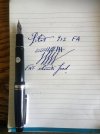- Messages
- 2,367
- Location
- Silly Suffolk
One pen with a flex gold nib that has eluded me is one of the Japanese Pilot pens with an FA (Falcon) #10 nib; a 742, 743 or 912. These pens are not sold in the UK, nor apparently in Europe (Appelboom, among others) which means going to a seller in Japan to buy one.
After a lot of thought and even more dithering, I ordered a 912, which was sent from Japan on 13th May and arrived on my doorstep 5 days later (thanks, FedEx).
Inked up with Diamine Sargasso Sea, a wet ink, it writes wetly, and flexes from fine to a shade over broad, without pushing it. However, I have ordered an ebonite feed from the Flexible Nib Factory in the USA, which should enable me to use a wider range of inks, including some drier.
The surprising thing is that the 912 costs considerably less than many other good pens (Lamy, Edison, other Pilots, Sailor, Platinum, Diplomat etc. etc.), a lot of which have steel nibs. The nib is far closer to a vintage flex or a modern Italian flex (Aurora, Scribo, usually about £500) than those with proprietary nibs (e.g. Pineider hyperflex) or the JoWo wing cutout flex nibs in steel or gold. At somewhere in the region of £150, it's remarkable value, for anyone who writes in copperplate and perhaps is looking for a more advanced and capable pen.
After a lot of thought and even more dithering, I ordered a 912, which was sent from Japan on 13th May and arrived on my doorstep 5 days later (thanks, FedEx).
Inked up with Diamine Sargasso Sea, a wet ink, it writes wetly, and flexes from fine to a shade over broad, without pushing it. However, I have ordered an ebonite feed from the Flexible Nib Factory in the USA, which should enable me to use a wider range of inks, including some drier.
The surprising thing is that the 912 costs considerably less than many other good pens (Lamy, Edison, other Pilots, Sailor, Platinum, Diplomat etc. etc.), a lot of which have steel nibs. The nib is far closer to a vintage flex or a modern Italian flex (Aurora, Scribo, usually about £500) than those with proprietary nibs (e.g. Pineider hyperflex) or the JoWo wing cutout flex nibs in steel or gold. At somewhere in the region of £150, it's remarkable value, for anyone who writes in copperplate and perhaps is looking for a more advanced and capable pen.
